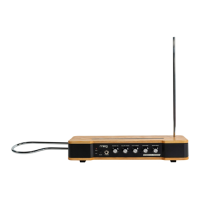21
CONTROLS AND FUNCTIONS (Continued)
TIMBRE PARAMETERS
This pair of parameters can be used to modify and transform the sound of your Etherwave Theremin
by changing the tonality and harmonic content to suit your preference or your performance.
Each parameter has its own function, but both are part of the analog wave shaping circuitry.
TIP: Begin with both the WAVEFORM and BRIGHTNESS knobs in the midpoint (12 o’clock) position.
WAVEFORM
This parameter controls the analog wave shape, thereby changing the
harmonic content. With this knob in the fully counterclockwise position,
the initial wave will resemble a pulse wave, creating a “reed” or “nasal” tone.
As the WAVEFORM knob is rotated clockwise, the initial wave will morph
into a slightly skewed triangle wave, creating a more “vocal” tone.
BRIGHTNESS
This parameter modifies the transient time (or slew) of the edges of
the wave itself to alter the harmonic content. Rotating the BRIGHTNESS
knob clockwise will increase the “sharpness” of the edges of the wave,
adding more overtones and increasing the harmonic content. Rotating the
BRIGHTNESS knob counterclockwise will produce a “rounder” edge to
the wave, resulting in fewer overtones, thus decreasing the harmonic content.
The midpoint (12 o’clock) position is a good starting place for a traditional
theremin timbre.
Triangle
Wave
Pulse
Wave
Sharper
Edges
Rounder
Edges

